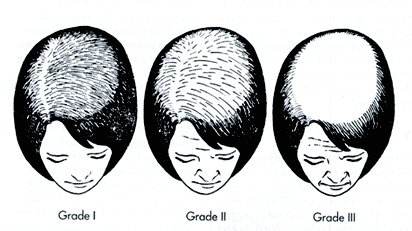


The Medical City
Rm 502 MATI Building
Ortigas Ave., Pasig City
Philippines 1605
Telfax: +63 (2) 636-2839
Hair Transplant Surgery
for WOMEN


THE LUDWIG CLASSIFICATION
FEMALE PATTERN HAIR LOSS (FPHL) is the genetic and progressive hair loss in women usually occurring over the midscalp and sparing the frontal hairline. Similar to Male Pattern Baldness, Female Pattern Baldness is characterized by miniaturization (becoming finer and thinner hairs) of hairs with the rate of loss being unpredictable. Diagnosing Female Pattern Hair loss is and may be difficult to treat.
HAIRLINE LOWERING is basically hair transplantation for women with high foreheads and who would want a lower, more aesthetically pleasing, but most of all appropriate hairline to frame their face.
EYEBROW & EYELASH RESTORATION/RESHAPING can be offered to those who have sparse eyebrows/eyelashes. People with thin or sparse eyebrows or eyelashes may be due to genetics or to trauma (over-plucking, burns, scars, etc). Eyebrow transplantation is a more common procedure than eyelash surgery. This is due to far better results and less seen complications from an eyebrow transplant compared with an eyelash transplant; hence proper patient selection is key to a satisfied client and a happy doctor. Patients who wish to reshape their eyebrows or to transplant over an existing eyebrow tattoo can also be done. The transplanted hairs will initially grow and will normally fall off by the 2 weeks time. You may wear large rimmed sunglasses. Regrowth will begin after 4 months. It is important to remember that trimming the transplanted hairs regularly is necessary for proper maintenance.
SCAR COVERAGE means transplanting hairs over hair bearing areas that had lost hairs due to formation of permanent scar tissue from trauma, burns, surgery, or scalp diseases causing permanent destruction of hair follicles and scarring (Scarring alopecias).
There are certain types of Scarring alopecias that occur more commonly among women than in men and a few of these are Frontal fibrosing alopecia (FFA) and Central centrifugal alopecia. Proper diagnosis is essential in the management of these diseases since medical treatment will be based on the type of inflammatory cells involved and surgical treatment (hair transplantation) is only recommended when the disease has been burnt out or stabilized without presence of inflammatory cells within a span of 2 years.
Go back to HOME
Telogen Effluvium is the diffuse thinning or shedding of hair caused by the early shifting of hairs into the resting/shedding state called telogen phase of the hair cycle. There are a number of causes of telogen effluvium and the most common of these are physical stressors (chronic illness, major surgery, anemia), psychological or emotional stress, certain medications (retinoids and other vitamin A derivatives, anticoagulants or blood thinners, cholesterol-lowering drugs, anticonvulsants, antidepressants, amphetamines, antifungals, antibiotics, beta blockers (hypertensive meds), anti-inflammation ie. naproxen, indomethacin, anti-gout medication), hormonal imbalances (pregnancy, birth control pills, hormone replacement therapy, anabolic steroids, prednisone and other steroids ), diet (eating disorders, crash diets), hypothyroidism.
Anagen Effluvium presents with diffuse hair loss after exposure to toxic chemicals and drugs such as with radiation and chemotherapy. Hair loss is most apparent 1-2 months after treatment. The hair follicles that shed are prematurely shifted to the anagen or growth phase of the hair cycle.
Hair loss in women is not as straight forward as in men and it is important to rule out other causes of hair loss that are transient and non-permanent such as Telogen Effluvium and Anagen Effluvium, which can mimic FPHL.



